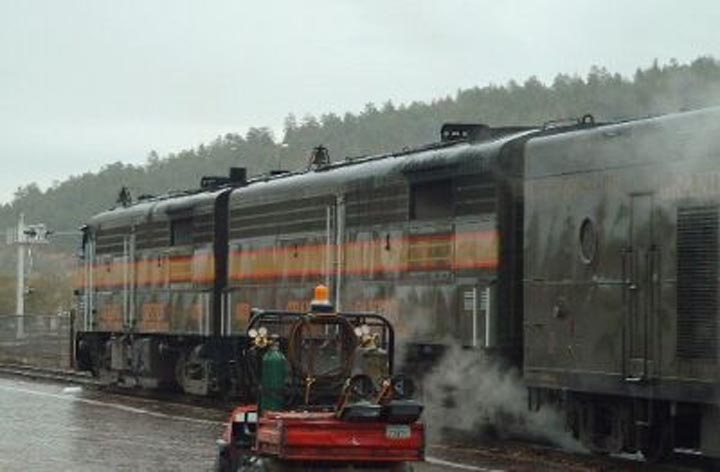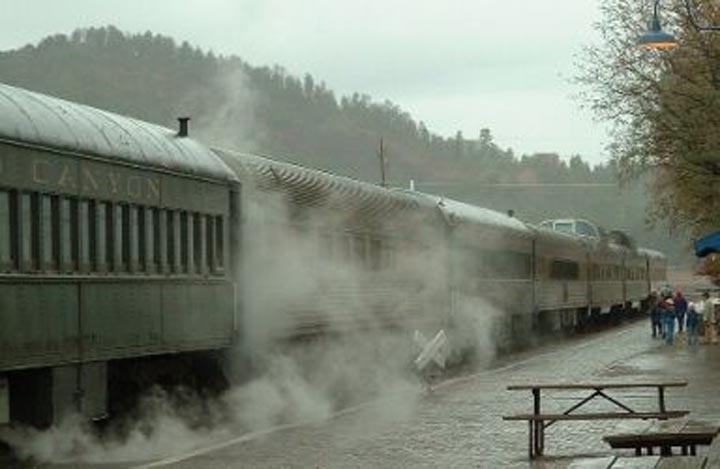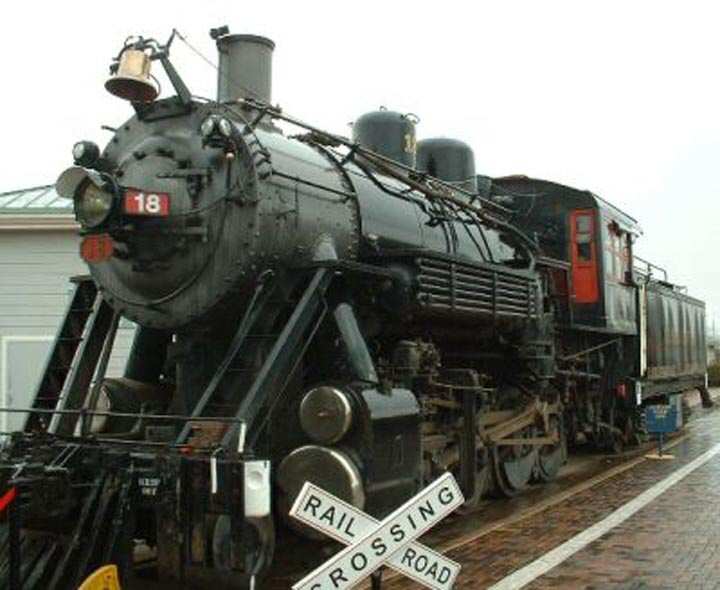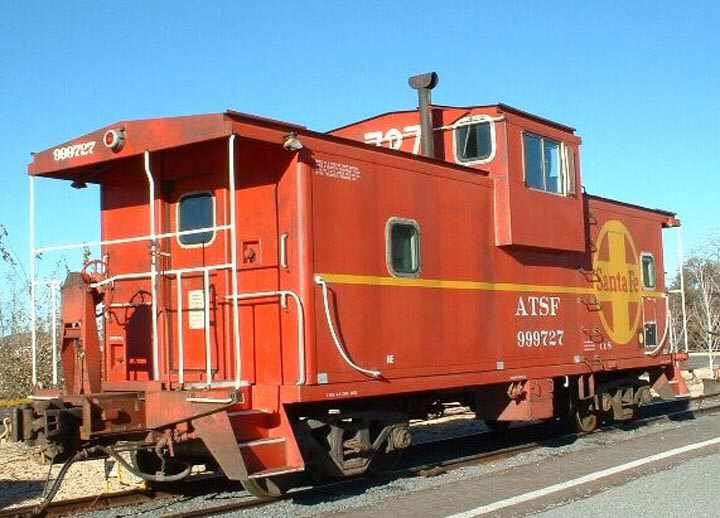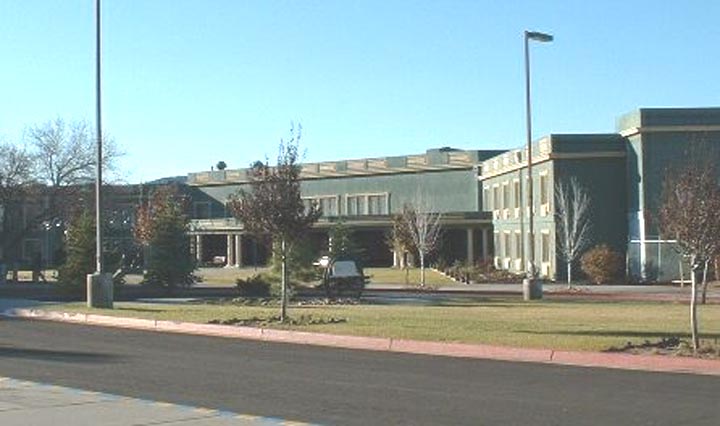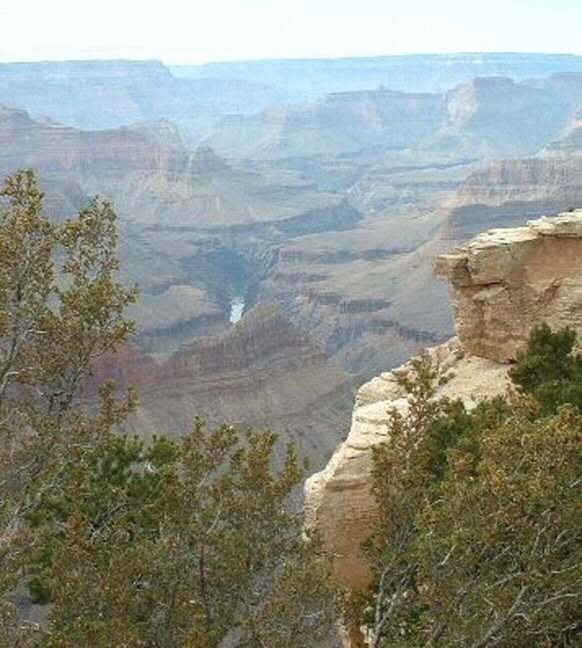A Grand Canyon Railway Adventure: Riding to a Natural Wonder
by Don Woodwell
It was a cool, drizzling November day when we pulled into the Williams Depot’s parking lot, but the excitement of riding the Grand Canyon Railway (GCRy) to the Grand Canyon after months of sharp anticipation pushed the dull weather to the back of our minds. Ahead of us lay what promised to be a truly fun and exciting day.
We quickly entered the century old Williams Depot, picked up the tickets which I had reserved several months before, and stepped out onto the platform where our train awaited us. An Alco FPA-4 A-B diesel set in GCRy livery headed up thirteen restored Harriman-style coaches and 1950s stainless steel cars for today’s 65-mile run to the Canyon climbing grades up to three percent and rounding 12-degree curves. The standard gauge line operates on a right-of-way through U.S. Forest Service and National Park Service land a significant part of which is owned by the GCRy.
The Williams Depot is one of the few buildings in Williams that has remained virtually unchanged in nearly 100 years. Listed in the National Registers of Historic Places (NRHP), the Williams Depot is the oldest poured concrete structure in Arizona. It survived destruction by the Santa Fe Railroad as, according to historians, it would have cost more to tear it down than pay taxes on it.
Williams, the gateway to the Grand Canyon, boasts a colorful past as a typical Western railroad town founded in 1882. It thrived because of successful farming and lumber industries as well as the railroad. At the turn of the last century, Williams had a reputation as a rowdy frontier town, but now it has the distinction of being the first community to place US Route 66 on the NRHP. It also has the dubious distinction of being the first town bypassed by Interstate 40 in 1984. Williams is not an upscale tourist Mecca, but its character today is largely as I found it 40 years ago when passing through on my way to southern California.
Every day before the train ride, local, colorful actors reenact a gunfight skit in a make believe Old West town on the western edge of the platform. Later that day these same cowboys “rob” the returning train as part of the ongoing passenger entertainment.
Now it was time to get going! The train crew began to board passengers. Coach, first class, dome car, club, and lounge services are available. We selected the coach class for the two and a quarter hour trip, and found it quite good. Each car has a resident “house mother” as well as a traveling — that is among the cars — guitarist. The “mother” tells stories about the Canyon and answers dozens of questions, and the guitar man sings and encourages group sing-alongs. For some, this train trip is merely an easy way to reach the Grand Canyon and the entertainment keeps boredom at bay. But as a rail fan, I was content enjoy the train’s motion and to watch and photograph the high plains scenery and look out for wildlife.
The first passengers boarded their train on September 17, 1901, and traveled through high desert plains and scrub forests, over small arroyos, and into the dense ponderosa pine forests as they neared the south rim. Before train travel, the only way to get to the Grand Canyon was by horseback or an uncomfortable and expensive 8-hour stagecoach ride from Flagstaff. The train provided a much more pleasant ride and the $3.95 ticket was affordable.
The motivation for the GCRy was, not surprisingly, money, but for a reason you may not suspect. Buckey O’Neil, an Arizona promoter, entrepreneur and politician, realized in 1893 that mining in Anita about 45 miles north of Williams could make money, and a railroad would have made it easy to get the ore to the ATSF mainline in Williams. After years of lobbying big city investment houses, the Santa Fe and Grand Canyon Railroad began laying tracks in 1898, and the ATSF finished the tracks all the way to the south rim by 1901 after an ownership change. More money was eventually made ferrying Canyon visitors than from hauling ore.
When we first visited the Grand Canyon in 1965, we drove from southern California where we lived at the time. Automobiles still account for the majority of tourist’s transportation, but it’s estimated that each year the GCRy has kept more than 50,000 cars outside the national park. A continuing problem at most popular national parks has been too many cars for years. At the Grand Canyon there is a railroad alternative — the GCRy. According to our tour bus driver, the National Park Service is considering banning automobiles and using only buses and the train.
Arrival at the Canyon’s south rim requires that the entire train be turned on the wye before pulling into the Grand Canyon Depot. When the train stopped we all piled out onto the platforms and many, including us, sought out a bus for a tour of the south rim and catered lunch at Bright Angel Lodge, one of the GC Village’s oldest buildings. The catered lunch was quite adequate and fueled us for the continuing adventures ahead.
The Santa Fe Railroad and its partner, the Fred Harvey Company, built an entire village on the south rim to service thousands of annual visitors. Grand Canyon Depot, constructed in 1910, was and still is located in the center of the fast paced village. Modern tourists arriving at the newly restored log depot have an authentic feel for what it was like to arrive at the Grand Canyon in the early part of the 1900’s. The GC Depot is only one of three remaining log depots out of fourteen built in the USA, and of these three it is the only one in which logs were the primary structural material and the only one of its kind serving an operating railroad.
Except for a brief period during WWII, at least one daily train was scheduled to pull into the Grand Canyon Depot between 1901 and 1968. In the early, 1920’s the first road connected Williams and the Park enabling cars to compete with train service. Between 1927 and 1933 the balance shifted between train passengers and automobiles. When the last scheduled train pulled into the GCD in 1968, only three passengers were aboard.
Park visitors arriving by train have about three and a quarter hours in which to tour the south rim. We chose to use the bus tour as we hoped to cram as many sights and narration into the available time. It turned out to be a good choice for us. Our driver and tour guide was not only knowledgeable about the Canyon and Village, but also a great storyteller. The morning overcast had largely disappeared and the sun peeked out as we looked into and marveled at the distant canyon vistas along the south rim.
Taking the south rim tour bus ensures that you will get back to the train on time. In order to maintain a strict operating schedule, the GCRy staff frequently reminded everyone to be on time. The return trip featured fewer stories and less music so we went to the lounge car for drinks at a table for two. The lounge and day coach were both refurbished Harriman-style cars, and reminiscent of an earlier era. I hadn’t been on one of these cars since riding Philadelphia commuter trains in the 1950’s.
By the late 1980’s the railroad was almost demolished for its salvage value, but the Grand Canyon Railway owned by Max and Thelma Biegert stopped the demolition work and began an extensive restoration project. Decaying tracks and roadbed were restored, the historic depots at each end of the line were subsequently renovated, and old locomotives and rolling stock were rebuilt. After twenty-one years, passenger service was restored to the Grand Canyon National Park.
The Cataract Creek Gang robbed the train about two-thirds the way back to Williams. This was the same bunch of rowdies who staged the gunfight in the morning near the depot. Each of the robbers “demanded” some change from the passengers until Marshall John B. Goodmore showed up and “arrested” the desperados. It was all in good fun, and it woke up many sleepy people. By the time we arrived in Williams, every one was wide awake and in fine spirits although a bit lighter in change.
It was nearly dusk but still light enough to see the GCRy rail yards where many passenger cars await future restoration, and the well-equipped shops capable of restoring steam engines with their heavy machine tools. The tracks leading into the depot parallel the BNSF right of way where in the morning a fast freight roared through town.
After 14 successful operating years, the GCRy property will be the future home of the Arizona State Railroad Museum. Max and Thelma generously donated 15 acres of downtown Williams’ real estate, and the Museum will be designed along the lines of the turntable and engine shop so as to highlight the state’s 76 railroads. The proposed location is the actual site of the ATSF’s Williams roundhouse. It has direct access to the BSNF mainline via the GCRy tracks. Such will expedite movement of the Museum’s display equipment.
We ended our day at the Williams depot and wrapped it up taking more video shots of the Alcos idling in the twilight. The company’s steam engines run Memorial Day weekend through Labor Day Weekend, and the Alco diesel locomotives run the remainder of the year.
A lot of happy travelers headed off into the parking lots to continue their journeys or to the nearby Fray Marcus hotel for their evening meal. Wherever they were headed each had a new story to tell about their adventure aboard a historic train that carried them to the awesome sights of the only natural wonder on the North American continent.
A deal between the GCRy and Amtrak resulted in the Southwest Chief stopping at Williams Junction. So if you want to do a great rail fan tour, get on the Chief in either Los Angeles or Chicago — or at any stop in between — and stopover in Williams for one or more days. Amtrak Vacations as well as the Grand Canyon Railway offer package tours that include overnight stays at the El Tovar Hotel or Bright Angel Lodge in the Park and at the Fray Marcos hotel at the GCRy Resort.
W. David Chambers, company president, says it best: “By traveling aboard the Grand Canyon Railroad you are not only experiencing an entertaining and historic journey, you are doing your part to help preserve the pristine beauty of the Grand Canyon.”
1. The Railway features multiple ALCO FPA-4 diesel locomotives built in 1959. The FPA-4 model is unique as its longer design accommodates a steam generator for heating the passenger cars.
2. The Train with steam billowing around the cars on a cool, damp, November morning, is ready for it run to the Grand Canyon.
3. Engine 18 is an SC-4 class locomotive built in 1910 by the American Locomotive Company (ALCO) in Pittsburgh, PA. It is a 2-8-0 consolidation-type engine. Number 18 — weighing in at 160 tons — made the re-inaugural run to the canyon on Sept. 17, 1989. The engine, now retired, is scheduled for future rebuilding.
4. Typical of the GCRy displays is this all-steel cupola caboose in ATSF livery which was originally part of roster with more than 900 similar cabooses.
5. The Fray Marcos hotel is the centerpiece of the GCRy resort in Williams.
6. This south rim view of the Grand Canyon with the Colorado River shining in the center was the reason traveled by the historic GCRy
7. Pappy, a member of the Cataract Creek Gang looks like he is losing his revolver during the train “holdup.”

